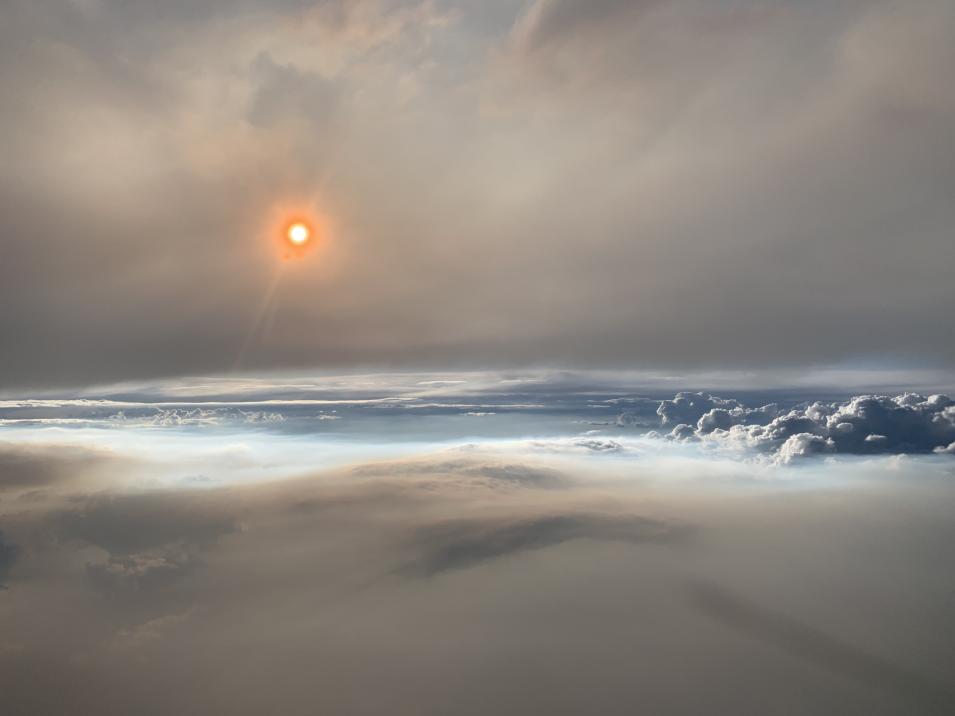Pyrocumulonimbus clouds—thunderstorms generated by wildfires—might seem like something out of science fiction, but they’re real, and seem to be occurring with greater frequency and intensity. For those who study aerosols—the solid particles, gasses, and liquid droplets suspended in the atmosphere—this is significant, as pyrocumulonimbus clouds can bring wildfire smoke and the particulates it contains to altitudes of 30,000 feet or higher.
Among the scientists interested in pyrocumulonimbus clouds and their ability to bring smoke to such lofty heights is Dr. David Peterson, a meteorologist with the Naval Research Laboratory’s (NRL) Marine Meteorology Division in Monterey, California. Peterson and his colleagues use satellite data and global aerosol models to monitor and track aerosols, including dust, pollution, sea salt, and smoke, that could impact Navy operations.
In the following interview, Peterson discusses the characteristics of pyrocumulonimbus (or pyroCb) events, the development and growth of the pyroCb research community, and how the study of pyroCb events would not be possible without the data from the Ozone Mapping and Profiler Suite (OMPS) instruments aboard the joint NASA/NOAA Suomi National Polar-orbiting Partnership (Suomi NPP) satellite and the Joint Polar Satellite System NOAA-20 and NOAA-21 satellites.
What is a pyroCb event?
A pyroCb event is a fire-generated thunderstorm. The abbreviation in weather for cumulonimbus is Cb, so by putting pyro in front of cumulonimbus, or Cb, you get pyrocumulonimbus or pyroCb. They're anchored directly to the fire such that the heat from the fire creates a bubble that helps trigger the development of a storm. Then the smoke that's released is fed straight up into the cloud. That's why we refer to these as giant chimneys—the smoke column is accelerated through the thunderstorm and released at whatever altitude the cloud reaches. That's at least 30,000 feet, but some of these extend into the stratosphere. We've seen smoke released from pyroCbs as high as 55 to 59 thousand feet.
One pyroCb event in British Columbia in 2017 changed the [pyroCb] community. A smoke plume from four or five pyroCbs was released into the stratosphere; at the time, it was one of the largest plumes ever seen at those altitudes, including plumes from volcanic eruptions. That plume travelled around the Northern Hemisphere and lasted eight months. It was the benchmark event. No one had ever seen anything like it. Then, in less than three years came the Australian fire season of 2019-2020. There was an outbreak of 38 pyroCb updrafts over the span of a few days that produced a plume roughly three times larger than the one from British Columbia. That plume travelled around the Southern Hemisphere and persisted for about 15 months.
This year, 2023, was [Canada's] worst fire season on record. It has also shattered our record for pyroCbs. Prior to 2023, 2021 was the most active year in Canada with 50 pyroCbs and 100 worldwide. This year Canada reached 50 pyroCbs by the third week of June. We're at 135 right now, so more than doubling 2021, and there have been 155 pyroCbs worldwide. Still, none of them by themselves have rivaled the stratospheric impact of Australia or the 2017 event in Canada.
You and your colleagues have been tracking the occurrence of pyroCbs for about a decade. What have you learned during that time?
Since 2013, we've been working to build the first pyroCb dataset for the globe; because the field is so new, you can't just go somewhere and download a record of pyroCbs. Our record is a little over a decade long now. That's not long enough to identify climate trends. What we do find, however, is that pyroCbs are fairly common and that they happen every year in certain regions of the globe. We generally expect to see around 40 or 50 events per year, meaning a fire that generates a pyroCb event. Previously, pyroCbs were considered to be phenomena that only occurred once in a while. We now know that's not true, that they happen every year, and we know a lot about the weather conditions that drive pyroCbs. That’s why they occur in specific regions.
Just because you have more wildfires doesn't necessarily mean you'll have more pyroCbs. You have to have a synergy of the right meteorological conditions and fire. In a region like Canada, you typically have both, but in other places, such as southern California in October, when you have the Santa Ana winds, that is not the right environment. Even though you can get very big devastating fires, they would not create pyroCb events. So, it depends on a couple of moving parts.
We've spent a lot of time on the weather aspect of pyroCbs at NRL. We wrote a paper that creates a conceptual model for what atmospheric conditions are required for a pyroCb event to occur. The fire, though, is something of a black box. We know they tend to be large and intense, but there are very few observations at the time pyroCbs occur to really quantify that. How large? How intense? What feedbacks are occurring? In the same way field measurements have helped us learn about tornado outbreaks, we need the same kind of information for pyroCbs to really understand what's going on.
Why are OMPS datasets so critical for monitoring and tracking smoke plumes from pyroCbs?
PyroCb smoke plumes have large quantities of light-absorbing aerosols and OMPS, with its UV wavelengths, is very good at picking up their signal. The primary OMPS product we use is called the ultraviolet aerosol index (UVAI). It's one of the primary tools we can use to track the movement of these plumes downwind. Plus, because it’s a global dataset, you can see the plume evolving day after day. Its also how we track a [plume's] magnitude. Higher values of the aerosol index generally means the plume is thick, dense, and at higher altitudes. We can also use it to capture the size of the plume by counting how many pixels it encompasses.
